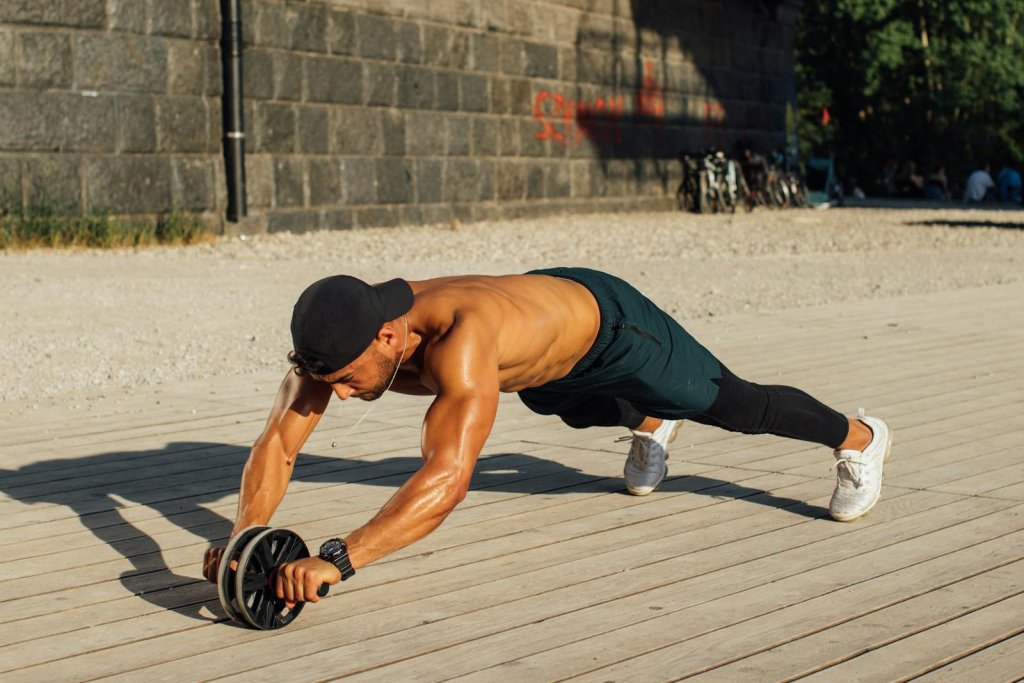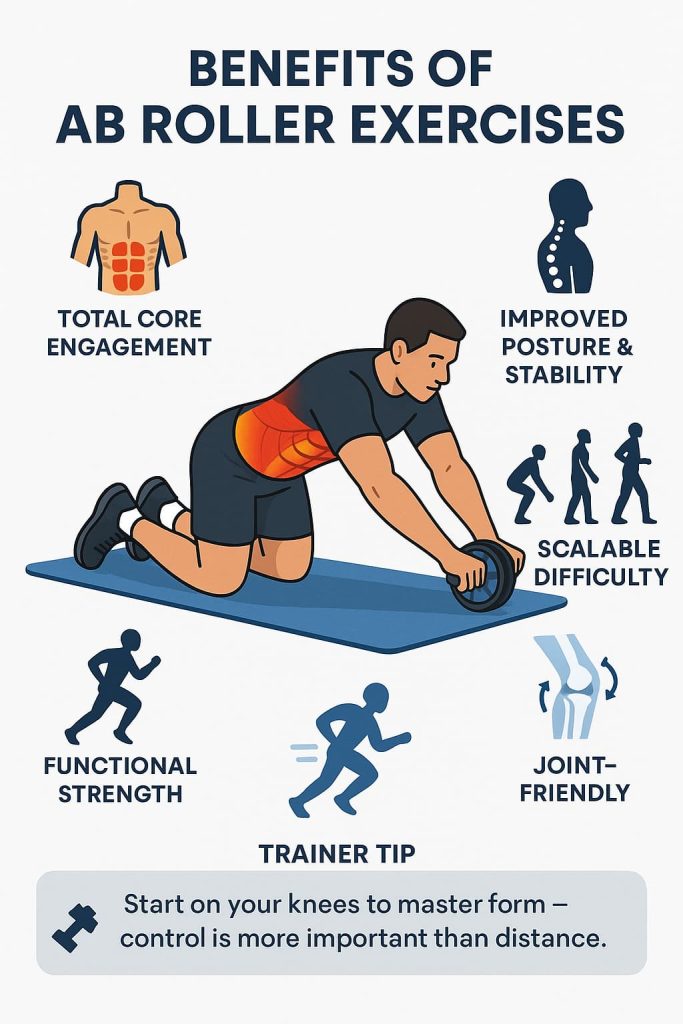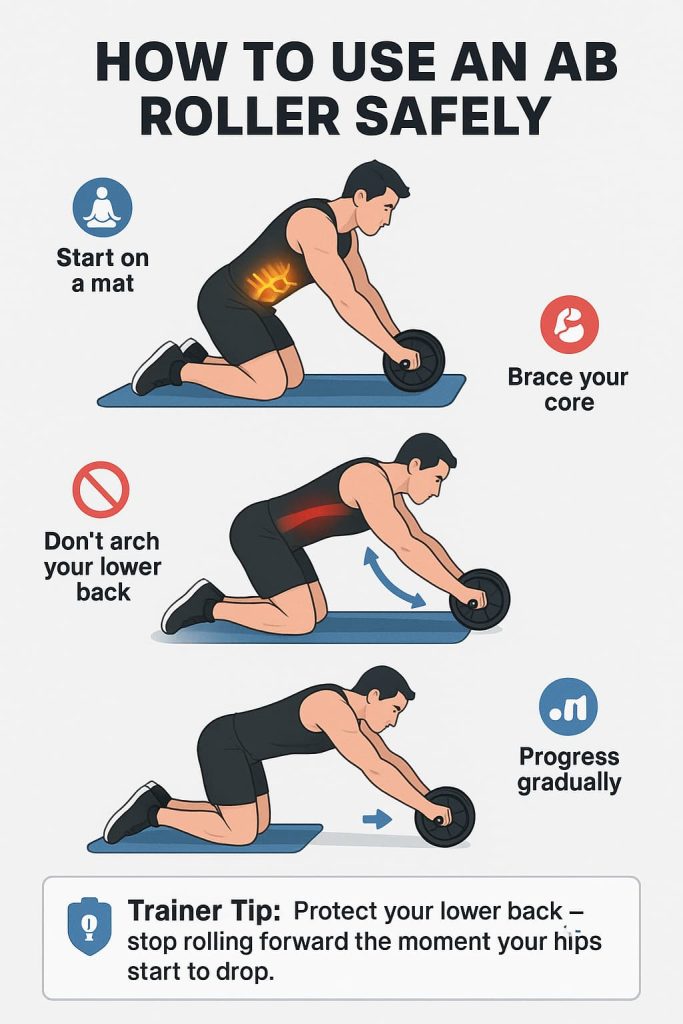Ab roller exercises are one of the most effective ways to strengthen and define your core.
They engage not just your abs but also your shoulders, back, and glutes — giving you total-body stability and power.

The ab wheel (or ab roller) might look simple, but when used correctly, it outperforms many traditional core exercises like sit-ups or crunches. Research on roll-out patterns shows very high core activation. A 2017 EMG study in the Journal of Human Kinetics reported rectus abdominis and external oblique activity at ~55–60% MVC during suspension roll-outs—higher than several other core moves tested.
Understanding how to use this compact tool properly can help you build strength, protect your spine, and carve out visible definition safely and efficiently.
Benefits of Ab Roller Exercises

- Total core engagement: Targets rectus abdominis, obliques, transverse abdominis, and lower back.
- Improved posture and stability: Strengthens the muscles supporting your spine.
- Scalable difficulty: Works for beginners (kneeling rollouts) to pros (standing or single-arm).
- Functional strength: Builds core endurance for sports and everyday movement.
- Joint-friendly: Low impact when performed with correct form.
How to Use an Ab Roller Safely

- Start on a mat to cushion your knees.
- Keep your core braced (as if taking a punch).
- Avoid letting your lower back arch — maintain a neutral spine.
- Roll only as far as you can control the return.
- Progress slowly — range matters more than distance.
💡 Trainer Tip: Before using the ab wheel, master plank and bird-dog exercises for baseline core strength.
The 9 Best Ab Roller Exercises
Below are the most effective ab roller moves from beginner to advanced — each designed to build strength, control, and definition.
1️. Kneeling Ab Wheel Rollout (Beginner-Friendly)
Why it works:
This foundational move strengthens your entire anterior core while teaching you to control your spine under tension. It’s safer for beginners because your knees support part of your body weight.
Muscles worked:
Rectus abdominis, obliques, shoulders, lats, hip flexors
How to do it:
- Kneel on a mat with the roller in front of you.
- Grip both handles firmly and roll forward slowly, extending your arms until your torso is nearly parallel to the ground.
- Keep your core tight and avoid letting your hips drop.
- Roll back to the starting position using controlled motion.
Trainer Tip:
Keep your abs braced the entire time — imagine pulling your ribs toward your pelvis to protect your spine.
2️. Ab Wheel Plank Hold
Why it works:
The unstable surface of the wheel makes this plank variation far more challenging than the traditional floor version. It forces your stabilizers to stay constantly engaged.
Muscles worked:
Transverse abdominis, shoulders, triceps, glutes
How to do it:
- Begin in a forearm plank position but grip the roller handles instead.
- Hold your body in a straight line from head to heels.
- Maintain tension without letting the roller move forward or back.
- Hold for 30–60 seconds.
Trainer Tip:
Focus on squeezing your glutes — it keeps your hips stable and prevents your back from sagging.
3️. V-Rollouts (Oblique Rollouts)
Why it works:
By rolling diagonally, you activate your internal and external obliques for better rotational control and core symmetry.
Muscles worked:
Obliques, rectus abdominis, shoulders, transverse abdominis
How to do it:
- Start in a kneeling rollout position.
- Roll the wheel forward and to the right at about a 45° angle.
- Pause, then return to the starting position.
- Repeat to the left side for one full rep.
Trainer Tip:
Avoid twisting your hips — keep them facing forward to isolate your obliques properly.
4️. Pike Rollouts
Why it works:
This move strengthens your upper abs and shoulders while enhancing coordination and balance. The inverted “V” position increases time under tension for your core.
Muscles worked:
Upper abs, hip flexors, shoulders, deltoids
How to do it:
- Start in a high plank position with your feet on the roller.
- Engage your core and lift your hips upward, rolling the wheel toward your hands.
- Slowly return to starting position.
Trainer Tip:
Move in a slow, controlled motion — don’t jerk or use momentum. Keep your legs as straight as possible.
5️. Standing Ab Wheel Rollout (Advanced)
Why it works:
This elite-level variation maximizes core and lat engagement, demanding extreme stability through your full range of motion.
Muscles worked:
Rectus abdominis, lats, lower back, glutes, deltoids
How to do it:
- Stand tall with the wheel on the floor in front of you.
- Hinge at your hips and place your hands on the handles.
- Roll forward slowly until your torso is nearly parallel to the floor.
- Reverse the movement with full control.
Trainer Tip:
Warm up thoroughly — even experienced lifters should progress gradually from kneeling to standing rollouts.
6️. Single-Arm Rollout
Why it works:
By isolating one arm, you create unilateral instability, which trains your obliques and deep stabilizers to resist rotation.
Muscles worked:
Obliques, transverse abdominis, shoulders, lats
How to do it:
- Begin in a kneeling position with one hand gripping the roller.
- Keep your free hand behind your back.
- Roll forward in a straight line, keeping your core tight and hips steady.
- Return slowly to the start.
Trainer Tip:
Start with a short range of motion — extend only halfway until your balance improves.
7️. Wide-Stance Rollout
Why it works:
Widening your stance gives more balance while allowing you to focus on deeper, more controlled ab contraction. Great for transitioning from kneeling to standing versions.
Muscles worked:
Rectus abdominis, lats, obliques, lower back
How to do it:
- From standing or kneeling, place your feet wider than shoulder-width apart.
- Roll the wheel forward, maintaining a flat back.
- Engage your abs and roll back to start.
Trainer Tip:
Keep tension constant — never let your abs relax at the top or bottom.
8️. Knee Tucks (Feet on Wheel)
Why it works:
This variation targets the lower abs while improving hip mobility and dynamic control. It’s excellent for developing a lean, balanced core.
Muscles worked:
Lower abs, hip flexors, glutes, shoulders
How to do it:
- Start in a plank with your feet resting on the ab roller.
- Pull your knees toward your chest as you exhale.
- Slowly extend your legs back to the plank position.
Trainer Tip:
Don’t let your lower back sag — keep your hips slightly lifted for full ab engagement.
9️. One-Leg Ab Roller Hold
Why it works:
This stability-based move builds anti-rotation strength and balance, engaging both your core and glutes simultaneously.
Muscles worked:
Core stabilizers, obliques, glutes, shoulders
How to do it:
- Get into a plank position with hands gripping the roller.
- Lift one leg off the ground and hold steady.
- Maintain the position for 20–30 seconds per side.
Trainer Tip:
Focus your gaze on a fixed point — it helps you balance and maintain alignment.
Common Ab Roller Mistakes to Avoid
| Mistake | Why It’s a Problem | Fix |
|---|---|---|
| Letting hips sag | Strains lower back | Keep core tight & glutes engaged |
| Rolling too far | Overextends spine | Limit range to where you can return safely |
| Bending elbows | Reduces ab tension | Keep arms straight, move from shoulders |
| Rushing reps | Loses control | Slow tempo for better activation |
Sample Ab Roller Workout Plan (Beginner to Advanced)
Building a strong, defined core with an ab roller requires progression — starting simple and increasing range, volume, and difficulty over time.
This 3-level plan helps you develop strength, control, and definition safely.
| Level | Focus | Exercises | Sets & Reps | Frequency |
|---|---|---|---|---|
| Beginner | Core control & form | Kneeling Rollout, Ab Wheel Plank Hold | 3×8–10 each | 2–3×/week |
| Intermediate | Strength & endurance | V-Rollouts, Wide-Stance Rollout, Knee Tucks | 4×10–12 each | 3×/week |
| Advanced | Power & full-core definition | Standing Rollout, Pike Rollout, Single-Arm Rollout, One-Leg Hold | 4–5×12–15 each | 3–4×/week |
FAQs
1. Are ab rollers safe for beginners?
Yes — start with kneeling rollouts and short ranges of motion. Avoid standing rollouts until you’ve built core control.
2. How often should I use the ab roller?
2–3 times per week is ideal for strength and definition without overtraining.
3. What muscles does the ab roller target most?
Primarily the rectus abdominis, obliques, transverse abdominis, and stabilizers like lats, delts, and glutes.
4. Can ab roller workouts replace crunches?
Yes — they provide a more functional and full-range contraction, working both concentric and eccentric phases.
5. Why does my lower back hurt during rollouts?
You’re likely overextending. Keep your core braced, avoid sagging hips, and reduce your range of motion.
6. How long until I see results?
With proper diet and consistency, visible definition can appear in 4–6 weeks.
7. Should I do ab rollers before or after workouts?
After your main strength training — fatigued abs can reduce stability during heavy lifts.
Conclusion
Ab roller exercises are compact, effective, and scientifically backed tools for building a rock-solid core. Whether you’re a beginner mastering control or an athlete chasing elite strength, consistent ab wheel training will deliver visible and functional results.
Start slow, focus on form, and roll your way to a stronger, defined midsection.